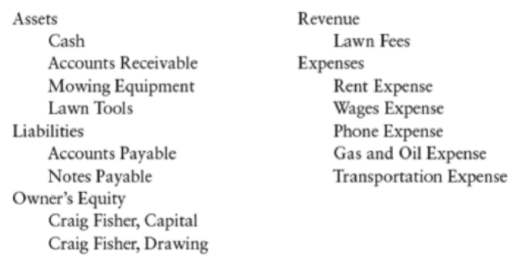Assets Revenue Cash Lawn Fees Accounts Receivable Expenses Rent Expense Wages Expense Phone Expense Gas and Oil Expense Transportation Expense Mowing Equipment Lawn Tools Liabilities Accounts Payable Notes Payable Owner's Equity Craig Fisher, Capital Craig Fisher, Drawing
Reporting Cash Flows
Reporting of cash flows means a statement of cash flow which is a financial statement. A cash flow statement is prepared by gathering all the data regarding inflows and outflows of a company. The cash flow statement includes cash inflows and outflows from various activities such as operating, financing, and investment. Reporting this statement is important because it is the main financial statement of the company.
Balance Sheet
A balance sheet is an integral part of the set of financial statements of an organization that reports the assets, liabilities, equity (shareholding) capital, other short and long-term debts, along with other related items. A balance sheet is one of the most critical measures of the financial performance and position of the company, and as the name suggests, the statement must balance the assets against the liabilities and equity. The assets are what the company owns, and the liabilities represent what the company owes. Equity represents the amount invested in the business, either by the promoters of the company or by external shareholders. The total assets must match total liabilities plus equity.
Financial Statements
Financial statements are written records of an organization which provide a true and real picture of business activities. It shows the financial position and the operating performance of the company. It is prepared at the end of every financial cycle. It includes three main components that are balance sheet, income statement and cash flow statement.
Owner's Capital
Before we begin to understand what Owner’s capital is and what Equity financing is to an organization, it is important to understand some basic accounting terminologies. A double-entry bookkeeping system Normal account balances are those which are expected to have either a debit balance or a credit balance, depending on the nature of the account. An asset account will have a debit balance as normal balance because an asset is a debit account. Similarly, a liability account will have the normal balance as a credit balance because it is amount owed, representing a credit account. Equity is also said to have a credit balance as its normal balance. However, sometimes the normal balances may be reversed, often due to incorrect journal or posting entries or other accounting/ clerical errors.
Craig Fisher started a lawn service called Craig's Quick Cut to earn
money over the summer months. Fisher has decided to use the following
accounts for recording transactions:
Transactions for the month of June are listed below.
(a) Invested cash in the business, $3,000.
(b) Bought mowing equipment for $1,000: paid $200 in cash and
promised to pay the balance over the next four months.
(c) Paid garage rent for June, $50.
(d) Provided lawn services for customers on account, $520.
(e) Paid phone bill, $30.
(f) Borrowed cash from the bank by signing a note payable, $500.
(g) Bought lawn tools, $480.
(h) Collected cash from customers for services performed on
account in transaction (d), $400.
(i) Paid associates for lawn work done during the first half of the
month, $350.
(j) Paid for gas and oil for the equipment, $60.
(k) Paid cash on account for the mowing equipment purchased in
transaction (b), $200.
(1) Earned lawn fees of $1,320: $600 in cash and $720 on account.
(m) Paid associates for last half of month, $700.
(n) Reimbursed associates for costs incurred using their own
vehicles for transportation, $150.
(0) Paid on note payable to bank, $100.
(p) Withdrew cash for personal use, $200.
REQUIRED
1. Enter the transactions for June in T accounts. Use the accounting
equation as a guide for setting up the T accounts.
2. Foot and balance the T accounts where necessary.
3. Prepare a
4. Prepare an income statement for the month ended June 30, 20--.
5. Prepare a statement of owner's equity for the month ended June
30, 20-
6. Prepare a balance sheet as of June 30, 20--.
REQUIRED
1. Enter the transactions in T accounts, identifying each
transaction with its corresponding letter.
2. Foot and balance the accounts where necessary.
3. Prepare a trial balance as of August 31, 20---

Trending now
This is a popular solution!
Step by step
Solved in 2 steps with 4 images




